Netherlands–United Kingdom relations
 | |
Netherlands |
United Kingdom |
|---|---|
| Diplomatic mission | |
| Embassy of the Netherlands, London | Embassy of the United Kingdom, The Hague |
| Envoy | |
| Ambassador Laetitia van den Assum | Ambassador Joanna Roper |
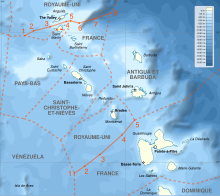
The Netherlands and the United Kingdom have a strong political and economic partnership.[1]
Over forty Dutch towns and cities are twinned with British towns and cities.[2] Both English and Dutch are West Germanic languages, with West Frisian, a minority language in the Netherlands, being the closest relative of the English language if one excludes Scots. In addition, between 90%[3] and 93%[4] of people in the Netherlands claim to speak English, although a negligible percentage of British people can speak Dutch.
The Netherlands has an embassy in London,[5] and the United Kingdom has an embassy in The Hague.[1] The UK also has a consulate in Willemstad, Curaçao.[6]
There are also strong ties[clarification needed] between the UK's overseas territory of Anguilla and the nearby Sint Maarten of the Netherlands. Both countries are members of the Council of Europe and NATO. the Netherlands is a European Union member and the United Kingdom is a former European Union member.
History
[edit]Early Modern Relations
[edit]
In the mid-seventeenth century, after the Dutch had made peace in their war of independence from Spain and the former Kingdoms of England, Scotland and Ireland were being united under Cromwell's Commonwealth, Oliver St John was sent to Holland to moot the possibility of unifying the Dutch Republic with the Commonwealth, as fellow Protestant, seafaring republics, though the plan did not come to pass.[7]
The Anglo-Dutch wars were battles between England (and the Kingdom of Great Britain during the fourth war) and the Dutch Republic during the 17th and 18th centuries. There were four wars in total, two were won by each side, and ended with the Fourth Anglo-Dutch War. The wars were largely fought to secure trade routes and to enable colonial expansion.[8]
Glorious Revolution
[edit]The Glorious Revolution, also called the Revolution of 1688, was the overthrow of King James II of England (VII of Scotland and II of Ireland) in 1688 by a union of English MPs with an invading army led by the Dutch Republic stadtholder William III of Orange-Nassau (William of Orange) who, as a result, ascended the English throne as William III of England.[9]
The crisis besetting King James II came to a head in 1688, when the King fathered a son, James Francis Edward Stuart on 10 June (Julian calendar),[10] until then the throne would have passed to his daughter, Mary, a Protestant and the wife of William of Orange. The prospect of a Catholic dynasty in the kingdoms was now likely. Already troubled by the King's Catholicism and his close ties with France, key leaders of the Tories united with members of the opposition Whigs and set out to resolve the crisis by inviting William of Orange to England.[11]
As a result of the Glorious Revolution, Anglo-Dutch relations entered a new era as the two nations were bound together by a shared sovereign. Despite the fact that anti-Dutch sentiment continued to be widespread among the English public, England and the Dutch Republic fought together in the Nine Years' War, the Williamite War in Ireland and the War of the Spanish Succession. As the 18th century went on, however, the Dutch gradually became the junior partner in the relationship, setting the stage for a deterioration in Anglo-Dutch relations.[citation needed]
Eight Articles of London
[edit]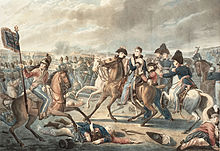
The Eight Articles of London, also known as the London Protocol of 21 June 1814, were a secret convention between the Great Powers: United Kingdom of Great Britain and Ireland, Prussia, Austria, and Russia to award the territory of current Belgium and the Netherlands to William I of the Netherlands, then "Sovereign Prince" of the United Netherlands. He accepted this award on 21 July 1814.[12]
Anglo-Dutch Treaty of 1814
[edit]The Anglo-Dutch Treaty of 1814 (also known as the Convention of London) was signed between the United Kingdom and the Netherlands in London on 13 August 1814. It was signed by Robert Stewart, Viscount Castlereagh, for the British and Hendrik Fagel for the Dutch.
The treaty returned the colonial possessions of the Dutch as they were at 1 January 1803 before the outbreak of the Napoleonic Wars, in the Americas, Africa, and Asia with the exceptions of the Cape of Good Hope and the South American settlements of Demerara, Essequibo, and Berbice, where the Dutch retained trading rights. In addition, the British ceded to the Dutch Bangka Island in the Indonesian Archipelago in exchange for the settlement of Kochi and its dependencies on the coast of Malabar, in India. The Dutch also ceded the district of Barnagore, situated close to Calcutta, in exchange for an annual fee. The treaty noted a declaration of 15 June 1814, by the Dutch that ships for the slave trade were no longer permitted in British ports and it agreed that this restriction would be extended to a ban on involvement in the slave trade by Dutch citizens. Britain also agreed to pay £1,000,000 to Sweden to resolve a claim to the Caribbean island of Guadeloupe (see Guadeloupe Fund). The British and the Dutch agreed to spend £2,000,000 each on improving the defences of the Low Countries. More funds, of up to £3,000,000, are mentioned for the "final and satisfactory settlement of the Low Countries in union with Holland." Disputes arising from this treaty were the subject of the Anglo-Dutch Treaty of 1824.
Anglo-Dutch Treaty of 1824
[edit]The Anglo-Dutch Treaty of 1824, also known as the Treaty of London (one of several), was signed between the United Kingdom and the United Kingdom of the Netherlands in London in March 1824. The treaty sought to resolve disputes arising from the execution of the Anglo-Dutch Treaty of 1814. For the Dutch, it was signed by Hendrik Fagel and Anton Reinhard Falck, and for the UK, George Canning and Charles Williams-Wynn.[13]
World War II
[edit]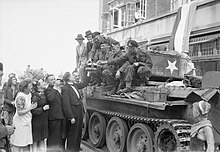
During World War II, the United Kingdom and the Netherlands were close allies. After the German occupation of the Netherlands, Queen Wilhelmina and the Dutch government found refuge in Britain. The Royal Netherlands Navy brought most of its ships to England.[14]
A few Dutch pilots escaped and joined the Royal Air Force to fight in the Battle of Britain. In July 1940, two all-Dutch squadrons were formed with Royal Netherlands Navy personnel and Fokker seaplanes from the Dutch naval air service: 320 Squadron and 321 Squadron (which afterwards moved to Sri Lanka). In 1943, an all-Dutch fighter squadron was formed in the UK, 322 Squadron.
Political relationship
[edit]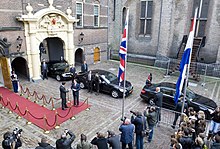
The United Kingdom and the Netherlands are both countries that are run under a constitutional monarchy. King Willem-Alexander of the Netherlands is around 890th in line to the British throne.
The United Kingdom and the Netherlands co-operate on a project to help people living in the developing world adapt to climate change.[15]
The Infrared Astronomical Satellite was the first-ever space-based observatory to perform a survey of the entire sky at infrared wavelengths. Launched in 1983, its mission lasted ten months. The telescope was a joint project of the Netherlands (NIVR), and the United Kingdom (SERC) as well as the USA.
While commenting on British-Dutch relations Doug Henderson stated in 1997 that:
We like fair play and straightforwardness (direct honesty). We have a deep interest and a sense of responsibility for what goes on in the wider world. We both share a commitment to global trade and have both traditionally promoted strong trans-Atlantic links. Furthermore, as former colonial powers, we both have important international interests.[16]
His Dutch counterpart Frits Bolkestein responded by saying:
In the past the Netherlands was a staunch supporter of British entry into the European community. Apart from feeling sympathy for the British people, this was motivated by our common value and interests, such as long-standing and deeply-rooted democratic tradition, the Atlantic outlook, the free market orientation and three large multinational companies, such as Royal Dutch Shell, Unilever and Reckitt Benckiser, with a common Anglo-Dutch origin.[16]
Economic partnership
[edit]Royal Dutch Shell, Unilever and Reckitt Benckiser are three multinational companies of the joint Anglo-Dutch businesses.[17][18][19] The Netherlands-British Chamber of Commerce was established to further economic co-operation between the two countries.[20] In 2006 the Netherlands imported £16.6bn worth of goods from the United Kingdom, making it the UK's fifth biggest export market.[21] Dutch-British trade is made simpler by good relations, transparent legal framework, sophisticated financial services system, good transport links and close geographical proximity.[21] It is possible to reach either country by train, Eurostar, ferry or aeroplane.[22]
On the local level, since 2022 there has been developed a special focus on mobility from the Dutch point of view towards the UK. In 2022 the embassy organised a Trade Mission and as a follow-up, the Trade Agencies of Amsterdam & Utrecht organised an inspiration mission to Manchester, Birmingham and London, together with the embassy. In 2024 Rotterdam and Flevoland joined them and they visited Bristol and London.
Twinnings
[edit] Alkmaar, North Holland and
Alkmaar, North Holland and  Bath, Somerset
Bath, Somerset Almelo, Overijssel and
Almelo, Overijssel and  Preston, Lancashire
Preston, Lancashire Almere, Flevoland and
Almere, Flevoland and  Milton Keynes (and associated town with the City of Lancaster)
Milton Keynes (and associated town with the City of Lancaster) Amstelveen, North Holland and
Amstelveen, North Holland and  Woking, Surrey
Woking, Surrey Amsterdam, North Holland and
Amsterdam, North Holland and  Manchester, Greater Manchester
Manchester, Greater Manchester Arnhem, Gelderland and
Arnhem, Gelderland and  Airdrie, North Lanarkshire
Airdrie, North Lanarkshire Arnhem, Gelderland and
Arnhem, Gelderland and  Croydon, Greater London
Croydon, Greater London Cuijk, North Brabant and
Cuijk, North Brabant and  Maldon, Essex
Maldon, Essex Delft, South Holland and
Delft, South Holland and  Kingston upon Thames, Greater London
Kingston upon Thames, Greater London Dordrecht, South Holland and
Dordrecht, South Holland and  Hastings, East Sussex
Hastings, East Sussex Gouda, South Holland and
Gouda, South Holland and  Gloucester, Gloucestershire
Gloucester, Gloucestershire Graft-De Rijp, North Holland and
Graft-De Rijp, North Holland and  Chalfont St. Giles, Buckinghamshire
Chalfont St. Giles, Buckinghamshire Groningen, Groningen Province and
Groningen, Groningen Province and  Newcastle-upon-Tyne, Tyne and Wear
Newcastle-upon-Tyne, Tyne and Wear Heemstede, North Holland and
Heemstede, North Holland and  Royal Leamington Spa, Warwickshire
Royal Leamington Spa, Warwickshire Haaren, North Brabant and
Haaren, North Brabant and  Desborough, Northamptonshire
Desborough, Northamptonshire Hellevoetsluis, South Holland and
Hellevoetsluis, South Holland and  Torbay, Devon
Torbay, Devon Leiden, South Holland and
Leiden, South Holland and  Oxford, Oxfordshire
Oxford, Oxfordshire Meerssen, Limburg and
Meerssen, Limburg and  Sherborne, Dorset
Sherborne, Dorset Rotterdam, South Holland and
Rotterdam, South Holland and  Hull, East Riding of Yorkshire
Hull, East Riding of Yorkshire Stampersgat, North Brabant and
Stampersgat, North Brabant and  Cheltenham, Gloucestershire
Cheltenham, Gloucestershire Zutphen, Gelderland and
Zutphen, Gelderland and  Shrewsbury, Shropshire
Shrewsbury, Shropshire
Armed forces
[edit]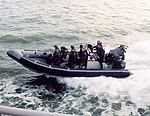
The Royal Marines and Netherlands Marine Corps are allied through a 'Bond of friendship'.
Since 1973, units of the Netherlands Marine Corps have formed part of the British 3 Commando Brigade during exercises and real conflict situations. Together, these form the UK/NL Landing Force. Either the First or the Second Marine Combat Group can be assigned as the Dutch contribution to this force.
The co-operation between the Korps Mariniers and the Royal Marines has led to extensive integration in the areas of operations, logistics and materials. Within NATO this is seen as a prime example of what can be achieved in military integration.
In combined NLMC and Royal Marines actions by the British and Dutch navies during the War of the Spanish Succession (1702–1713), amphibious operations were carried out, the most notable being the capture of Gibraltar in 1704. During this action, a successful attack was carried out against the fortress of Gibraltar by an 1800-strong brigade of Dutch and British Marines under the command of Prince George of Hesse-Darmstadt. Both corps share this battle honour.[citation needed]
The nickname of the Dutch Marines among their British Royal Marine counterparts is "Cloggies", a reference to the historic wearing of clogs by some Dutch people. Royal Navy Submarine Service officers taking the Submarine Command Course use a Dutch submarine simulator for part of the course.[citation needed]
Resident diplomatic missions
[edit]- the Netherlands has an embassy in London as well as a network of honorary consulates throughout the UK, Guernsey, Gibraltar and Bermuda.
- United Kingdom has an embassy and a consulate-general in The Hague and honorary consulates in Willemstad and Philipsburg, Sint Maarten.
-
Embassy of the Netherlands in London
-
Embassy of the United Kingdom in The Hague
See also
[edit]- Foreign relations of the United Kingdom
- Foreign relations of the Netherlands
- List of diplomats from the United Kingdom to the Netherlands
- Dutch people in the United Kingdom
- List of Dutch Britons
- United Kingdom–European Union relations
- Germany–United Kingdom relations
- Germany–Netherlands relations
References
[edit]- ^ a b "British Embassy The Hague – GOV.UK". Retrieved 18 May 2016.
- ^ "Country Profile: Netherlands". fco.gov.uk. Archived from the original on 19 October 2012. Retrieved 21 April 2018.
- ^ "European Union" (PDF). Retrieved 26 April 2023.
- ^ ""English in the Netherlands: Functions, forms and attitudes" p. 316 and onwards" (PDF). wordpress.com. Archived from the original (PDF) on 4 March 2016. Retrieved 21 April 2018.
- ^ Zaken, Ministerie van Buitenlandse. "The United Kingdom". www.netherlands-embassy.org.uk. Archived from the original on 10 January 2010. Retrieved 21 April 2018.
- ^ "Worldwide organisations". Retrieved 18 May 2016.
- ^ Godwin, William (1827). History of the Commonwealth of England Vol. 3. H. Colburn. pps.372–382.
- ^ "The First Anglo-Dutch War". Retrieved 18 May 2016.
- ^ "History in the making: The Glorious Revolution of 1688-91 was really a". The Independent. 28 December 1992. Retrieved 12 February 2024.
- ^ In this article "New Style" means the start of year is adjusted to 1 January. Events on the European mainland are usually given using the Gregorian calendar, while events in Great Britain and Ireland are usually given using the Julian calendar with the year adjusted to 1 January. Dates with no explicit Julian or Gregorian postscript will be using the same calendar as the last date with an explicit postscript.
- ^ Barry Coward, The Stuart Age (1980) 298–302
- ^ Colenbrander, p. LXX, fn. 1
- ^ "traktaat van Londen, 1824". Retrieved 18 May 2016.
- ^ Neal Wigglesworth, Holland at War Against Hitler: Anglo-Dutch Relations, 1940–1945 (Psychology Press, 1990)
- ^ "European Commission : CORDIS : News and Events : UK and Netherlands launch climate change adaptation study". Retrieved 18 May 2016.
- ^ a b Ashton, Nigel John; Hellema, Duco (2001). Unspoken Allies. Amsterdam University Press. ISBN 9789053564714. Retrieved 18 May 2016.
- ^ "Too many UK companies fail to see the point of history Queen Mary, University of London". qmul.ac.uk. Archived from the original on 7 October 2008. Retrieved 21 April 2018.
- ^ "Royal Dutch Shell". Retrieved 18 May 2016.
- ^ "BBC NEWS – Business – Qatar and Shell in $6bn gas deal". 28 February 2005. Retrieved 18 May 2016.
- ^ "The Netherlands British Chamber of Commerce". NBCC. Retrieved 18 May 2016.
- ^ a b Europe. Western Europe. Netherlands Archived 13 February 2006 at the Wayback Machine
- ^ "LONDON to AMSTERDAM by train & ferry or Eurostar from £49". Retrieved 18 May 2016.
Further reading
[edit]- Ashton, Nigel. Unspoken Allies: Anglo-Dutch Relations since 1780. ISBN 978-90-5356-471-4. Google Books
- Horn, David Bayne. Great Britain and Europe in the eighteenth century (1967). Covers 1603–1702; pp. 86–110. [1]
- Jones, James Rees. The Anglo-Dutch Wars of the Seventeenth Century (Routledge, 2013) [2]
- Levy, Jack S. "The Rise and Decline of the Anglo-Dutch Rivalry, 1609–1689", pp. 172–200 in William R. Thompson, ed. Great power rivalries (1999) online
- Palmer, M. A. J. "The Military Revolution Afloat: The Era of the Anglo-Dutch Wars and the Transition to Modern Warfare at Sea". War in History (1997) 4#2. pp. 123–149.
- Raven, G. J. A., and Nicholas A. M. Rodger. Navies and Armies: The Anglo-Dutch Relationship in War and Peace, 1688–1988 (John Donald, 1990).
- Watson, Charles Albert (1969). Britain's Dutch Policy, 1914–1918; The View from British Archives (Ph.D.). Boston University. OCLC 7805023.
- Wigglesworth, Neil. Holland at War Against Hitler: Anglo-Dutch Relations, 1940–1945 (Psychology Press, 1990) online
- Wilson, Charles Henry. Anglo-Dutch Commerce & Finance in the Eighteenth Century (1941) online



